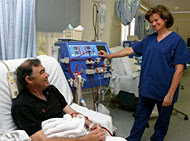 |
| Image Source: goa-health-travel.co.in |
• Passed by the US Congress in 1972
• The Medicare End-Stage Renal Disease (ESRD) Program
• This gives Medicare to patients who are entitled to Social Security based on their work records (93%) of all patients.
• Covers both dialysis and kidney transplants
• Medicare pays 80% of allowable costs. Insurance, state programs or patients pays the other 20%.
• Today, kidney failure is still the only disease with its own Medicare program.
• More centers began to open.
• Most centers are free-standing
• 2/3 are part of a large dialysis organization (LDO), a company that owns many centers all over the country.
• Each year, there are fewer and larger LDOs as they buy more centers.
• Centers are paid a composite rate by Medicare for each treatment.
• Based on the patient's age, weight, and height. And is different for each patient.
• Covers overhead, staff wages and training, equipment, rehabilitation, and some drugs.
• The composite rate is not raised each year for inflation the way hospitals and nursing homes rates are. Instead, congress must pass a law to raise the rate.
Insurance
• Second source of income for centers
• During the first 30 months of treatment, if patients have an employer group health plan (EGHP) through a job or a spouse's job, that plan is primary - it pays first.
• 126,000 USD per patient, per year (Medicare pays 63,000 USD)
ESRD Networks
• Set in 1978 to oversee the quality of dialysis care across the country.
• 18 ESRD Networks, most are non-profit, all are under contract with Medicare to cover a region of 1 -6 states.
• Charged to promote rehabilitation, collect and report data, and do quality improvement projects.
• Also offer a patient grievance process and provides resources to staff and patients.


0 comments:
Post a Comment